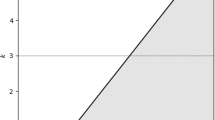Abstract
We consider a system of N point particles moving on a d-dimensional torus \(\mathbb{T}^{d}\). Each particle is subject to a uniform field E and random speed conserving collisions \(\mathbf{v}_{i}\to\mathbf{v}_{i}'\) with \(|\mathbf{v}_{i}|=|\mathbf{v}_{i}'|\). This model is a variant of the Drude-Lorentz model of electrical conduction (Ashcroft and Mermin in Solid state physics. Brooks Cole, Pacific Grove, 1983). In order to avoid heating by the external field, the particles also interact with a Gaussian thermostat which keeps the total kinetic energy of the system constant. The thermostat induces a mean-field type of interaction between the particles. Here we prove that, starting from a product measure, in the limit N→∞, the one particle velocity distribution f(q,v,t) satisfies a self consistent Vlasov-Boltzmann equation, for all finite time t. This is a consequence of “propagation of chaos”, which we also prove for this model.
Similar content being viewed by others
References
Ashcroft, N.W., Mermin, N.D.: Solid State Physics. Brooks Cole, Pacific Grove (1983)
Bastea, S., Esposito, R., Lebowitz, J.L., Marra, R.: Binary fluids with long range segregating interaction I: Derivation of kinetic and hydrodynamic equations. J. Stat. Phys. 101, 1087–1136 (2000)
Bonetto, F., Daems, D., Lebowitz, J.L., Ricci, V.: Properties of stationary nonequilibrium states in the thermostatted periodic Lorentz gas: the multiparticle system. Phys. Rev. E 65, 051204 (2002)
Bonetto, F., Chernov, N., Korepanov, A., Lebowitz, J.L.: Spatial structure of stationary nonequilibrium states in the thermostated periodic Lorentz gas. J. Stat. Phys. 146, 1221–1243 (2012)
Bonetto, F., Chernov, N., Korepanov, A., Lebowitz, J.L.: Nonequilibrium stationary state of a current-carrying thermostatted system. Europhys. Lett. 102, 15001 (2013)
Braun, W., Hepp, K.: The Vlasov dynamics and its fluctuations in the 1/N limit of interacting classical particles. Commun. Math. Phys. 56, 101–113 (1977)
Chernov, N., Eyink, G.L., Lebowitz, J.L., Sinai, Ya.G.: Steady state electric conductivity in the periodic Lorentz gas. Commun. Math. Phys. 154, 569–601 (1993)
Doob, J.L.: Stochastic Processes. Wiley, New York (1953)
Grunbaum, A.: Propagation of chaos for the Boltzmann equation. Arch. Ration. Mech. Anal. 42, 323–345 (1971)
Kac, M.: Foundations of kinetic theory. In: Neyman, J. (ed.) Proc. 3rd Berkeley Symp. Math. Stat. Prob., vol. 3, pp. 171–197. Univ. of California, Berkeley (1956)
Lanford, O.: Time evolution of large classical systems. In: Moser, J. (ed.) Dynamical Systems, pp. 1–97 (1975)
Moran, B., Hoover, W.: Diffusion in the periodic Lorentz billiard. J. Stat. Phys. 48, 709–726 (1987)
Mouhot, C., Mischler, S.: Kac program in kinetic theory. Invent. Math. 193, 1–147 (2013)
Neunzert, H.: An introduction to the nonlinear Boltzmann-Vlasov equation. In: Cercignani, C. (ed.) Lecture Notes in Mathematics, vol. 1048, pp. 80–100 (1984)
Spohn, H.: Kinetic equations from Hamiltonian dynamics: Markovian limits. Rev. Mod. Phys. 56, 569 (1980)
Spohn, H.: Large Scale Dynamics of Interacting Particles. Springer, Berlin (1991)
Sznitman, A.: Equations de type Boltzmann, spatialment homogenes. Z. Wahrscheinlichkeitstheor. Verw. Geb. 66, 559–592 (1984)
Wennberg, B., Wondmagegne, Y.: Stationary states for the Kac equation with a Gaussian thermostat. Nonlinearity 17, 633–648 (2004)
Acknowledgements
F. Bonetto, R. Esposito and R. Marra gratefully acknowledge the hospitality of Rutgers University, and E. A. Carlen and J. L. Lebowitz gratefully acknowledge the hospitality of Università di Roma Tor Vergata.
Author information
Authors and Affiliations
Corresponding author
Additional information
Dedicated to Herbert Spohn in friendship and appreciation.
Work of E.A. Carlen is partially supported by U.S. National Science Foundation grant DMS 1201354.
Work of J.L. Lebowitz is partially supported by U.S. National Science Foundation grant PHY 0965859.
Work of R. Marra is partially supported by MIUR and GNFM-INdAM.
Appendix: Properties of the Boltzmann Equation
Appendix: Properties of the Boltzmann Equation
In this appendix, we prove existence and uniqueness for our Boltzmann equation. As in the proof of Theorem 1.3, we do this first in the spatially homogeneous case, where the notation is less cumbersome, and then explain how to extend the argument to phase space.
As we have indicated, the key is the fact that the current satisfies an autonomous equation. Let \(\tilde{\mathbf {j}}_{0}\) be computed from f 0(v), the initial data for (1.6). Then solve for \(\tilde{\mathbf {j}}(t)\). Using this expression for \(\tilde{\mathbf {j}}\) in (1.6) we obtain the equation
where \(\mathcal{C}\) denotes the collision operator on the right side of (1.6), and where \({\bf Y}(\mathbf{v},t)\) is the vector field
which is linear, and hence globally Lipschitz. Let Φ t (v) denote the flow corresponding to this vector field, so that v(t):=Φ t (v) is the unique solution to \(\dot {\mathbf{v}}(t) = {\bf Y}(\mathbf{v}(t),t)\) with v(0)=v. Calling g(v,t) the push-forward of f(v,t) under the flow transformation Φ t , that is g(v,t)=det(DΦ t (v))f(Φ t (v),t), where DΦ t is the Jacobian of Φ t , we deduce that f(v,t) satisfies (A.1) if and only if g(v,t) satisfies
where
Under our hypotheses, \(\widetilde {\mathcal{C}}_{t}\) is bounded for each t, and depends continuously on t, and hence existence and uniqueness of solutions of (A.3) is straightforward to prove. It is also straightforward to prove that the current generated by the solution f(v,t) satisfies the differential equation and initial conditions of Lemma 1.2 and hence it equals \(\tilde{\mathbf {j}}\).
To obtain the same result in the spatially inhomogeneous case, we replace the vector field \({\bf Y}\) in (A.2) by
and let Φ t be the phase space flow it generates. Again, the vector field is linear and hence globally Lipschitz which guarantees the existence, uniqueness and smoothness of flow. Now the same argument may be repeated.
Rights and permissions
About this article
Cite this article
Bonetto, F., Carlen, E.A., Esposito, R. et al. Propagation of Chaos for a Thermostated Kinetic Model. J Stat Phys 154, 265–285 (2014). https://doi.org/10.1007/s10955-013-0861-2
Received:
Accepted:
Published:
Issue Date:
DOI: https://doi.org/10.1007/s10955-013-0861-2




